Class 9 FRANK Solutions Physics Chapter 2 - Motion in One Dimension
Learn about vector and scalar quantities using Frank Solutions for ICSE Class 9 Physics Chapter 2 Motion in one dimension. Understand the concept of motion with relevant examples given in our model answers. These chapter solutions help you with reference answers by experts to prepare for your Science exam.
You can find the complete Frank textbook solutions for ICSE Class 9 Physics at TopperLearning 24/7. For doubts and solutions related to Chapter 2, visit the ‘UnDoubt’ section at our study portal.
61
62
79
80
81
83
84
85
86
87
Motion in One Dimension Exercise 61
Solution 1
A body is said to be in state of rest if it does not change its position with respect to its surrounding objects with time.
Solution 2
A vector quantity is that physical quantity which is represented by both magnitude and direction.
Solution 3
No mass is not a vector quantity.
Solution 4
A vector is represented by an arrow. The length of the arrow represents the magnitude of vector quantity and arrow head gives the direction of vector quantity.
Solution 5
If a book is lying in almirah then it is at rest.
Solution 6
A body is said to be in motion when it change its position with respect to its surrounding objects with time.
Solution 7
Yes rest and motion are relative to each other.
Solution 8
Out of Force and Energy, Force is a vector quantity.
Solution 9
Examples of scalars are distance and mass.
Solution 10
Out of these positions, (i) and (ii) positions of body lie on same straight line as direction of these two are same.
Solution 11
A vector quantity is represented only when its magnitude and direction are specified so this quantity is a vector quantity.
Motion in One Dimension Exercise 62
Solution 12
Passengers sitting in a train are at rest with respect to each other.
Solution 13
Yes we are at rest as well as motion because we are at rest with respect to a observer which is itself at rest and we are in motion with respect to a observer which is in motion.
Solution 14
The platform is in motion with respect to train. As train is moving with respect to platform so platform would also look in motion with respect to train.
Solution 15
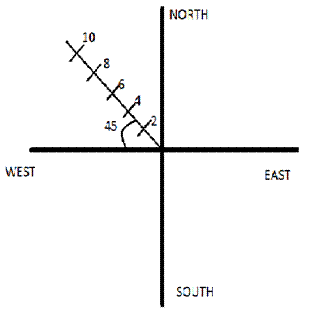
Solution 16
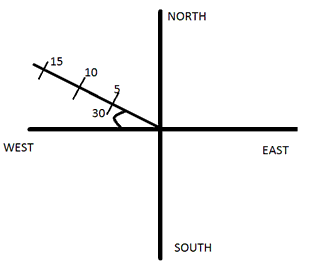
Solution 17
The physical quantity representing the magnitude and its direction is a vector quantity.
Solution 18
(i) Yes we can add two scalars.
(ii) Yes we can add two vectors.
(iii) Yes we can multiply two scalars.
(iv) No we cannot add a scalar quantity to a vector quantity.
(v) Yes we can subtract two scalars.
(vi) No we cannot subtract a scalar quantity from a vector quantity. Reverse is also not true.
(vii) Yes we can multiply vectors.
(ii) Yes we can add two vectors.
(iii) Yes we can multiply two scalars.
(iv) No we cannot add a scalar quantity to a vector quantity.
(v) Yes we can subtract two scalars.
(vi) No we cannot subtract a scalar quantity from a vector quantity. Reverse is also not true.
(vii) Yes we can multiply vectors.
Solution 19
The actual length of the path covered by a moving object irrespective of its direction of motion is called the distance travelled by the object.
Solution 20
No the distance covered by a body cannot be less than the magnitude of its displacement.
Solution 21
The displacement of a moving body is defined as the change in its position along a particular direction
Solution 22
SI unit for measurement of distance and diplacement is metre denoted by m.
Solution 23
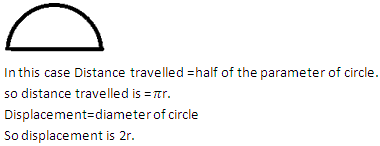
Solution 24
Yes a body can have negative displacement.
Solution 25
If a body is moving in a straight line then the displacement of a body is equal to the distance travelled by it.
Solution 26
(i) Distance is a scalar quantity whereas displacement is a vector quantity.
(ii) Distance is always positive but displacement can be negative,zero or positive.
(ii) Distance is always positive but displacement can be negative,zero or positive.
Solution 27
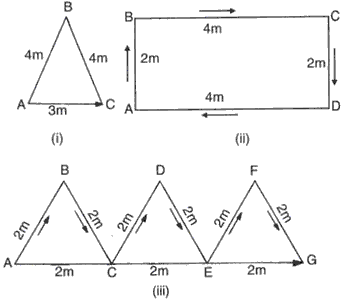
(i) Distance is 4+4=8 m while displacement is 3m.
(ii) Distance is 2+4+2+4=12m while displacement is 0m.
(iii) Distance is 2+2+2+2+2+2=12m while displacement is 2+2+2=6m.
Solution 28
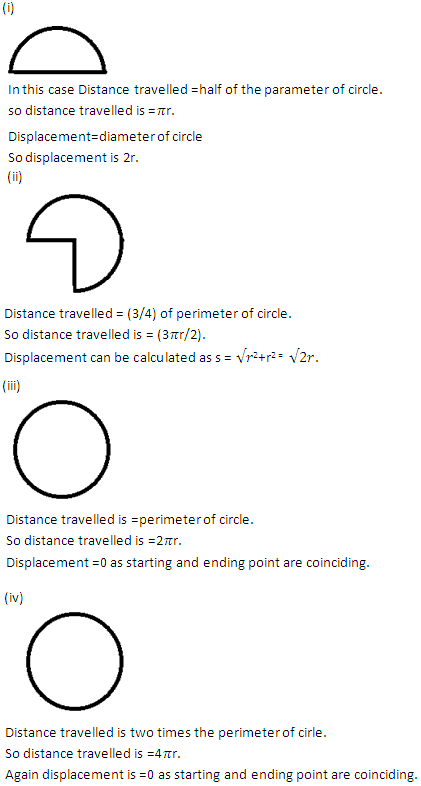
Solution 29
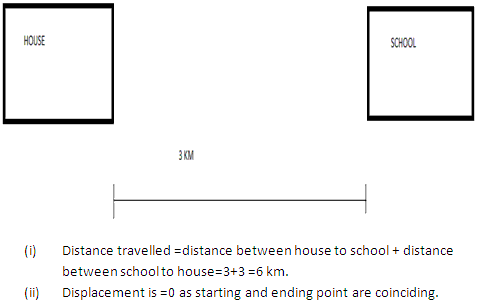
Solution 30
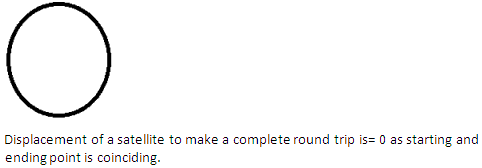
Solution 31
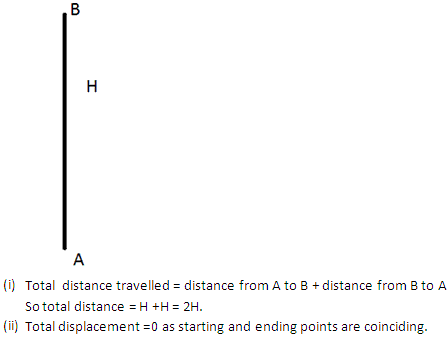
Motion in One Dimension Exercise 79
Solution 1
Speed of a body can be defined as distance covered by the body in unit time.
Solution 2
Average speed of a body can be defined as ratio of total distance covered by a body In total time.
Solution 3
Both speed and average speed have same unit and that is ms-1.
Solution 4
No speed and average speed of a body have different meaning.
Solution 5
60 km/hr can be converted into m/s to compare with 15m/s.
60 km/hr = (60 X 1000)/3600 = 16.66 m/s. so speed 60 km/hr is greater.
60 km/hr = (60 X 1000)/3600 = 16.66 m/s. so speed 60 km/hr is greater.
Solution 6
20m/s can be converted inti km/hr as
20 m/s = (20 X 3600)/1000 = 72 km/hr.
20 m/s = (20 X 3600)/1000 = 72 km/hr.
Solution 7

Solution 8
SI unit of velocity is ms-1.
Solution 9
No as their direction is different they don't have same velocity.
Solution 10
we convert all the speeds in m/s to compare them.
36 km/hr = (36 X 1000)/3600 = 10m/s.
2 km/min = (2 X 1000)/60 = 33.3 m/s.
7 m/s = 7 m/s.
So increasing order of speed is 7m/s < 10m/s <33m/s.
36 km/hr = (36 X 1000)/3600 = 10m/s.
2 km/min = (2 X 1000)/60 = 33.3 m/s.
7 m/s = 7 m/s.
So increasing order of speed is 7m/s < 10m/s <33m/s.
Solution 11
let total distance be S.
Boy covers distance S/2 with speed u then time taken by him to cover this distance would be T1 =S/2u.
Again boy covers rest of the distance S/2 with speed v then time taken by him to cover this distance would be T2 =S/2v.
So total time taken by boy to cover the distance S is T = T1 + T2.
Total time T= S/2 (1/u +1/v) = s(u+v)/2uv.
And average speed = S/T = 2uv/(u+v).
Boy covers distance S/2 with speed u then time taken by him to cover this distance would be T1 =S/2u.
Again boy covers rest of the distance S/2 with speed v then time taken by him to cover this distance would be T2 =S/2v.
So total time taken by boy to cover the distance S is T = T1 + T2.
Total time T= S/2 (1/u +1/v) = s(u+v)/2uv.
And average speed = S/T = 2uv/(u+v).
Solution 12
Yes uniform speed and constant speed have same meaning.
Solution 13
let S be the distance between P and Q.
Body covers forward journey distance S (P to Q) with speed u then time taken by him to cover this distance would be T1 =S/u.
Again body covers backward journey distance S (Q to P) with speed v then time taken by him to cover this distance would be T2 =S/v.
So total time taken by body to cover the distance S is T = T1 + T2.
Total time T= S (1/u +1/v) = s(u+v)/uv.
And average speed = 2S/T = 2uv/(u+v).
Body covers forward journey distance S (P to Q) with speed u then time taken by him to cover this distance would be T1 =S/u.
Again body covers backward journey distance S (Q to P) with speed v then time taken by him to cover this distance would be T2 =S/v.
So total time taken by body to cover the distance S is T = T1 + T2.
Total time T= S (1/u +1/v) = s(u+v)/uv.
And average speed = 2S/T = 2uv/(u+v).
Solution 14
As body goes from P to Q and then return back to P so the displacement of the body would be zero and hence average velocity would also be zero.
Solution 15
let distance between P and Q is S.
Speed of car while travelling from P to Q is 20 m/s.
Let car take time T1 to travel from P to Q then T1= S/20.
Speed of car while travelling from Q to P is 30 m/s.
Let car take time T2 to travel from Q to P then T2= S/30.
Total time = T1 + T2 = S/20 +S/30 =S/12.
So average speed of journey = total distance/ total time = 2S/(S/12) = 24 m/s.
Average speed of journey is 24 m/s.
Speed of car while travelling from P to Q is 20 m/s.
Let car take time T1 to travel from P to Q then T1= S/20.
Speed of car while travelling from Q to P is 30 m/s.
Let car take time T2 to travel from Q to P then T2= S/30.
Total time = T1 + T2 = S/20 +S/30 =S/12.
So average speed of journey = total distance/ total time = 2S/(S/12) = 24 m/s.
Average speed of journey is 24 m/s.
Solution 16
Speed is a scalar quantity whereas velocity is a vector quantity. So speed doesn't have its direction and velocity has a particular direction.
Solution 17
Speed and velocity of a moving body become equal when the body moves in a straight line.
Solution 18
When the velocity of a moving body doesn't change with time then the velocity of the body is said to be constant or uniform.Yes uniform velocity and constant velocity are one and the same thing.
Solution 19
Acceleration of a body is rate of change of its velocity with respect to the time.
Solution 20
SI unit of acceleration is ms-2.
Motion in One Dimension Exercise 80
Solution 21
If the acceleration of a moving body is constant in magnitude and direction then the path of the body must not be a straight line because in circular motion also acceleration of a body is constant in magnitude and always directed towards the centre.
So the path of the body may be a straight line and may be a circular one.
So the path of the body may be a straight line and may be a circular one.
Solution 22
No the relation S = v X t cannot used to find the total distance covered by a body moving with non-uniform speed.
Solution 23
Yes area under a speed time graph in a given interval gives the total distance covered by a body.
Solution 24
Yes the motion is uniform and the uniform speed is given by area under speed time graph divided by time interval.
So speed = 500/20 =25 m/s.
So speed = 500/20 =25 m/s.
Solution 25
Positive acceleration corresponds to situation when velocity is continuously increasing with respect to the time.
Solution 26
Negative acceleration corresponds to situation when velocity is continuously decereasing with respect to the time.
Solution 27
If a body falls towards earth then it would have a positive acceleration.
Solution 28
If a body has acceleration of 8.5 ms-2 then it means its velocity is increasing at a rate of 8.5 ms-1 per second.
Solution 29
SI unit of retardation is ms-2.
Solution 30
first convert 60 km/h in m/s.
60 km/hr =(60 X 1000)/3600 = 16.7 m/s.
This is initial velocity of car i.e u = 16.7 m/s.
As car stops in 10 seconds so final velocity is =0 m/s.
So acceleration = (v-u)/t = (0-16.7)/10 = -1.67 ms-2.
Acceleration of car is = -1.67 ms-2.
60 km/hr =(60 X 1000)/3600 = 16.7 m/s.
This is initial velocity of car i.e u = 16.7 m/s.
As car stops in 10 seconds so final velocity is =0 m/s.
So acceleration = (v-u)/t = (0-16.7)/10 = -1.67 ms-2.
Acceleration of car is = -1.67 ms-2.
Solution 31
-30 m/s is speed.
Solution 32
Velocity corresponds to the rate of change of displacement.
Solution 33
No the speed of a body cannot be negative.
Solution 34
A flying bird most likely to have a non uniform velocity.
Solution 35
Let initial velocity be u.
Final velocity is v= 0 m/s.
Time taken by body to come to rest = 10 sec.
Retardation =2.5 ms-2.
We know v = u +at.
Then u = v - at.
u = 0 - (-2.5 X 10) = 25 m/s.
So initial velocity of the body is 25 m/s.
Final velocity is v= 0 m/s.
Time taken by body to come to rest = 10 sec.
Retardation =2.5 ms-2.
We know v = u +at.
Then u = v - at.
u = 0 - (-2.5 X 10) = 25 m/s.
So initial velocity of the body is 25 m/s.
Solution 36
Equation of motion gives us the picture of motion of moving body.
Solution 37
First equation of motion is v = u + at.
Second equation of motion is s= ut + 1/2a t2.
Third eqution of motion is v2 - u2 =2as.
Second equation of motion is s= ut + 1/2a t2.
Third eqution of motion is v2 - u2 =2as.
Solution 38
Four variables are present in each equation of motion.
Solution 39
Four variables are present in each equation of motion and if any of three is known to us then fourth can be easily find with the help of these equation of motion.
Solution 40
SI unit of acceleration and retardation is ms-2.
Solution 41
Distance is the physical quantity which is equal to the area under speed-time graph.
Solution 42
A uniformly accelerated motion is one in which speed is constantly increasing or decreasing with time while a non uniform motion is one in which speed is not constantly changing with time.
Solution 43
No we cannot use this relation for a body moving with uniform acceleration.
Solution 44
Slope of a graph is given as rate of change of y coordinates to the x coordinate. In speed time graph speed is on the y axis and time is on the x axis. And we define acceleration as rate of change of speed with respect to time. So slope of a speed time graph gives acceleration.
Solution 45
(i) Motion of blades of an electric fan.
(ii) Motion of moon around earth.
(ii) Motion of moon around earth.
Solution 46
A straight line curve on speed time graph indicates that acceleration of the body is uniform and a zigzag or curved line indicates that acceleration of a body is not uniform.
Solution 47
Two quantities are directly proportional to each other.
Solution 48
As we distance = speed X time.
Speed = 42 km/hr.
Time = 10 m = 1/6 hr.
Distance = 42 X 1/6 =7 km.
Speed = 42 km/hr.
Time = 10 m = 1/6 hr.
Distance = 42 X 1/6 =7 km.
Solution 49
Initial velocity u =10 ms-1.
Acceleration a = 2 ms-2.
Time t = 10 s.
By using first equation of motion
V = u + at.
V = 10 + 2 X 10.
V (final velocity) = 30 ms-1.
Acceleration a = 2 ms-2.
Time t = 10 s.
By using first equation of motion
V = u + at.
V = 10 + 2 X 10.
V (final velocity) = 30 ms-1.
Solution 50
Initial velocity u = 10 km/hr. = (10 X 1000)/3600 = 8.33 ms-1.
Final velocity = 64 km/hr = (64 X 1000)/3600 = 17.77 ms-1.
Time = 10 s.
Acceleration = (v-u)/t = (17.77- 8.33)/10 = 9.44/10 = 0.94 ms-2.
Final velocity = 64 km/hr = (64 X 1000)/3600 = 17.77 ms-1.
Time = 10 s.
Acceleration = (v-u)/t = (17.77- 8.33)/10 = 9.44/10 = 0.94 ms-2.
Motion in One Dimension Exercise 81
Solution 51
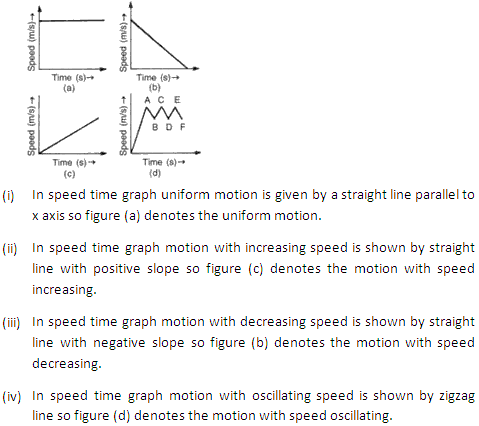
Solution 52
No a body cannot have a speed negative.
Solution 53
No2 distance covered by body during nth second is not more than the distance covered in n seconds.
Solution 54
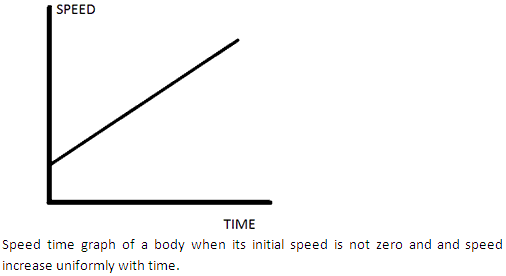
Solution 55
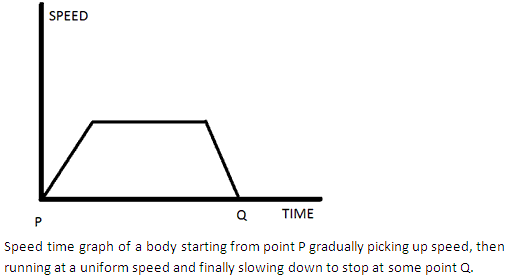
Solution 56
If speed time graph is moving upward then the body is accelerating and if it is starting from origin then it means the body has initial velocity =0.
Solution 57
Speed time graph is moving upward then the body is accelerating and if it is not starting from origin then it means the body has some initial velocity.
Solution 58

Solution 59

Solution 60
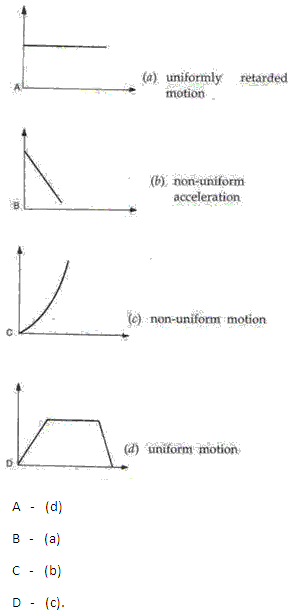
Solution 61
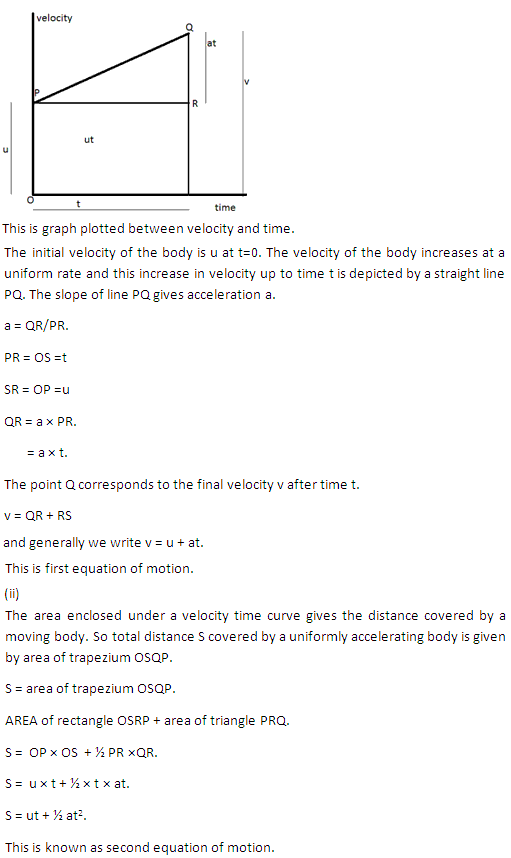
Solution 62

Motion in One Dimension Exercise 83
Solution 1
Displacement and velocity are two examples of vectors.
Solution 2
SI unit of retardation is ms-2.
Solution 3
Velocity is the physical quantity associated with the rate of change of displacement with time.
Solution 4
Solution 5
There are three types of rectilinear motion Translational , vibrational and rotational.
Solution 6
A body is said to have a uniform velocity if it covers equal displacement in equal interval of time.
Solution 7
Acceleration is a vector quantity.
Solution 8
Slope of speed time graph represents acceleration.
Solution 9
If a stone is dropped from a certain height then it undergoes non uniform velocity motion.
Solution 10
This means the body has a positive acceleration.
Solution 11
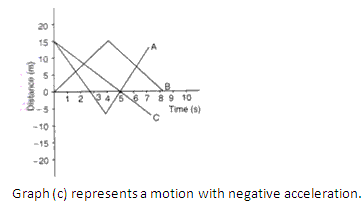
Solution 12
(i) No a body with constant acceleration cannot have a zero velocity.
(ii) No a body with an acceleration in vertical direction cannot move horizontally.
(iii) No in an accelerated motion a body cannot have a constant velocity.
(ii) No a body with an acceleration in vertical direction cannot move horizontally.
(iii) No in an accelerated motion a body cannot have a constant velocity.
Solution 13
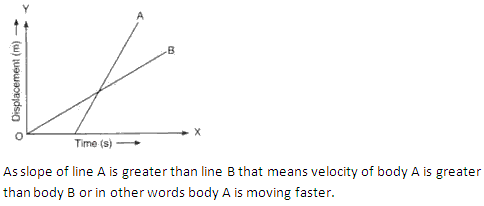
Solution 14
(i) In displacement-time graph a straight line parallel to time axis shows that body is at rest position.
(ii) In displacement-time graph a straight line inclined to the time axis with an acute angle means body is moving with a positive velocity.
(ii) In displacement-time graph a straight line inclined to the time axis with an acute angle means body is moving with a positive velocity.
Solution 15
No a accelerating body cannot have constant speed.
Solution 16
(i) In displacement-time graph a straight line shows body is at rest if it is parallel to time axis and shows a body is moving with uniform velocity if it is inclined to x axis.
(ii) In velocity-time graph a straight line shows body is moving with uniform constant velocity if it is parallel to x axis and shows body is moving constant acceleration of it is inclined to x axis.
(ii) In velocity-time graph a straight line shows body is moving with uniform constant velocity if it is parallel to x axis and shows body is moving constant acceleration of it is inclined to x axis.
Solution 17
Average speed during different time intervals for a uniform motion is same.
Solution 18
Velocity of a stone thrown vertically upward at its maximum height is Zero.
Solution 19
Velocity of a stone thrown vertically upwards decrease because acceleration due to gravity is acting on downward direction.
Solution 20
Linear velocity would be equal to linear speed if body is moving in a straight line.
Solution 21
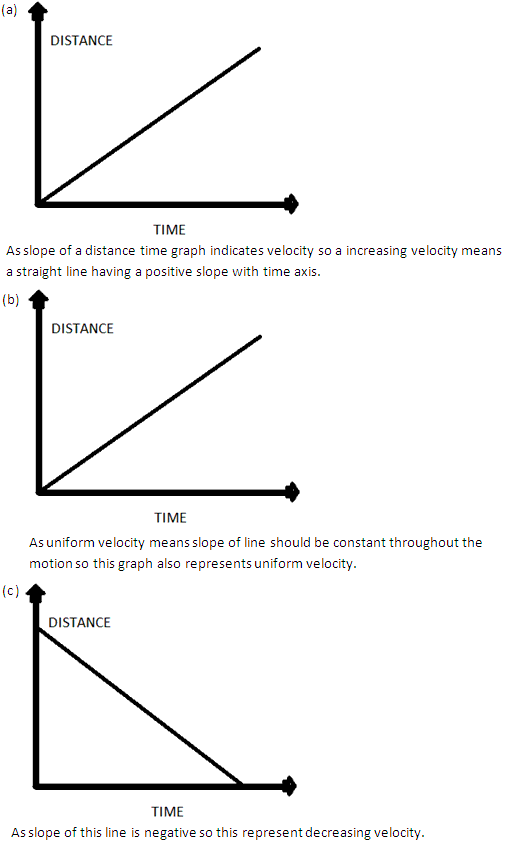
Solution 22
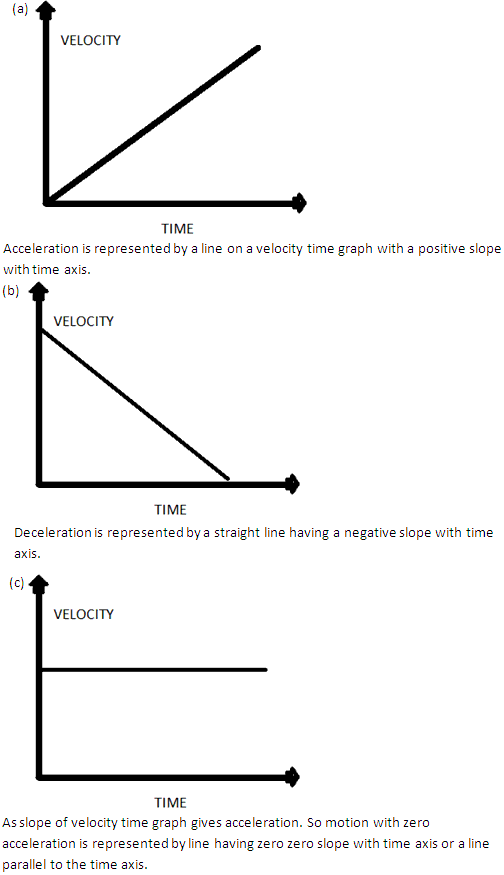
Motion in One Dimension Exercise 84
Solution 23
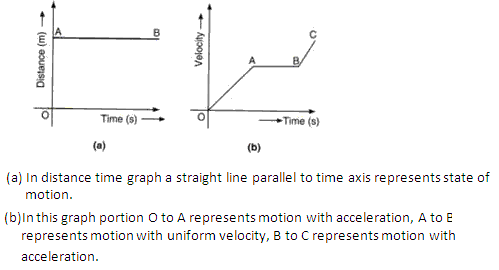
Solution 24
During circular motion
(a) Speed remains constant.
(b) Velocity changes continuously.
(a) Speed remains constant.
(b) Velocity changes continuously.
Solution 25
The statement is not correct , the correct statement is "the earth is moves round the sun with constant speed".
Solution 26
As in circular motion direction changes continuously with motion so after two complete revolutions we can say that direction has changed infinite times.
Solution 27
As after completing 3 revolution in circular motion the displacement is = 0. so the ratio of distance covered to the displacement is infinite.
Solution 28
The graph becomes straight line with positive slope with time axis and represents almost a constant acceleration.
Solution 29
Retardation is negative of acceleration so retardation the body is +3.4 ms-2.
Solution 30
Bus is moving with initial velocity of u = 60 km/hr.
60 km/hr = ( 60 X 1000)/3600 = u = 16.66 ms-1.
Reaction time = t =1/15 sec.
Distance would the bus had moved before pressing the bus would be = u X t.
S = 16.66 X 1/15 = 1.1 m.
Now if the driver is intoxiacated then reaction time would be t = 1/2 seconds.
So S becomes S = u X t = 16.66 X 1/2 = 8.33m.
60 km/hr = ( 60 X 1000)/3600 = u = 16.66 ms-1.
Reaction time = t =1/15 sec.
Distance would the bus had moved before pressing the bus would be = u X t.
S = 16.66 X 1/15 = 1.1 m.
Now if the driver is intoxiacated then reaction time would be t = 1/2 seconds.
So S becomes S = u X t = 16.66 X 1/2 = 8.33m.
Solution 31
Time difference of 0.1 s denotes the time taken by sound to go from device to wall and back to wall. As the distance between wall and device is 15 m so total distance covered by sound is 2 X 15 m =30 m.
So speed of sound is = total distance covered/time taken = 30/0.1 =300 ms-1.
So speed of sound is 300 ms-1.
So speed of sound is = total distance covered/time taken = 30/0.1 =300 ms-1.
So speed of sound is 300 ms-1.
Solution 32

Solution 33
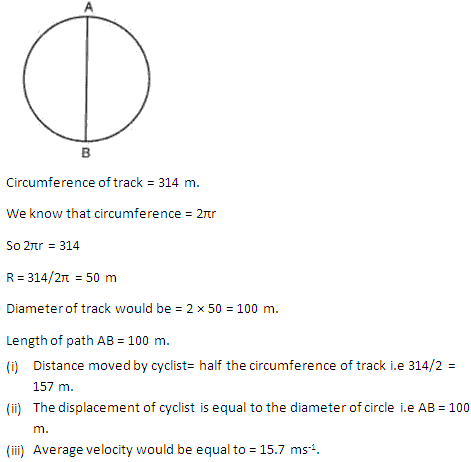
Solution 34
slope of velocity time graph represents acceleration of the body.
Solution 35

Motion in One Dimension Exercise 85
Solution 36
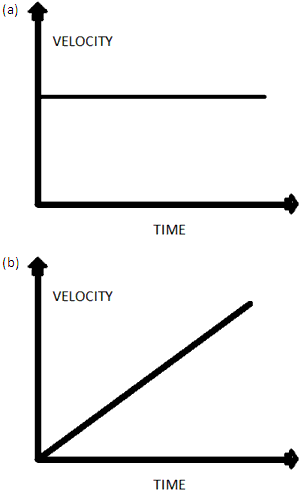
Solution 37
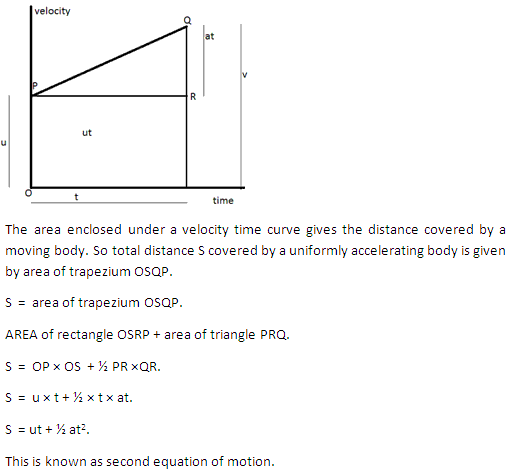
Solution 38
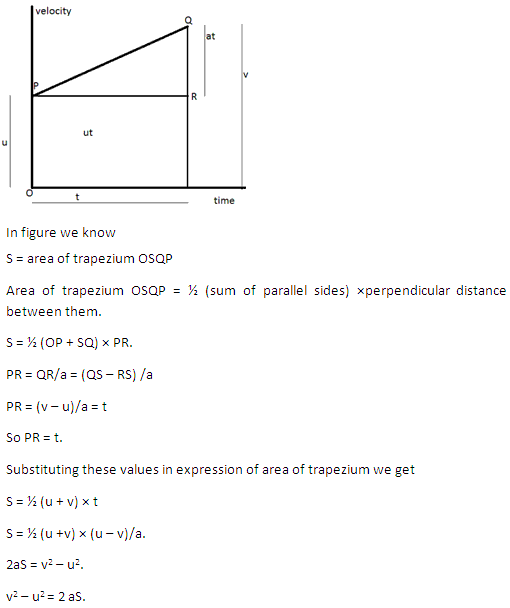
Solution 39
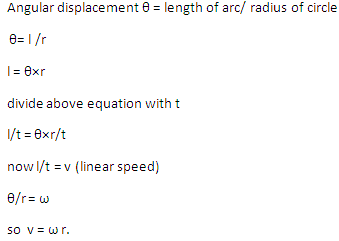
Solution 40
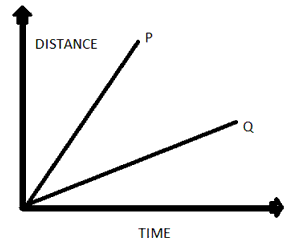
Solution 41
let total distance be S.
Boy covers distance S/2 with speed A then time taken by him to cover this distance would be T1 =S/2A.
Again boy covers rest of the distance S/2 with speed B then time taken by him to cover this distance would be T2 =S/2B.
So total time taken by boy to cover the distance S is T = T1 + T2.
Total time T= S/2 (1/A +1/B) = s(A+B)/2AB.
And average speed = S/T = 2AB/(A+B).
Boy covers distance S/2 with speed A then time taken by him to cover this distance would be T1 =S/2A.
Again boy covers rest of the distance S/2 with speed B then time taken by him to cover this distance would be T2 =S/2B.
So total time taken by boy to cover the distance S is T = T1 + T2.
Total time T= S/2 (1/A +1/B) = s(A+B)/2AB.
And average speed = S/T = 2AB/(A+B).
Solution 42
Car travls 30 km distance with speed 60 km/hr
Time taken by car to travel this distance = 30/60 = 0.5 hr.
Car travels another distance of 30 km with speed of 20 km/hr.
Time taken by car to travel this distance = 30/20 = 1.5 hr.
Total time taken = 1.5 + 0.5 = 2 hr.
Total distance = 30+ 30 = 60 km.
Average speed of car = 60/2 = 30 km/hr.
Time taken by car to travel this distance = 30/60 = 0.5 hr.
Car travels another distance of 30 km with speed of 20 km/hr.
Time taken by car to travel this distance = 30/20 = 1.5 hr.
Total time taken = 1.5 + 0.5 = 2 hr.
Total distance = 30+ 30 = 60 km.
Average speed of car = 60/2 = 30 km/hr.
Solution 43
Train travels first 40 km at speed of 30 km/hr.
Time taken by train to cover this distance is = distance/speed = 40/30 = 4/3 hr.
Let speed of train to cover next 80 km is v .
Then time taken by train to cover these 80 km is 80/v.
Total time becomes T = 4/3 +80/v = ( 4v + 240)/3v.
Total distance= 120 km.
Average speed = 60 km/h (given)
However average is given by = total distance /total time.
So (120 X 3 X v)/(4v +240) = 60
360 v = 240v +14400
120v = 14400
v= 14400/120 =120 km/hr.
so train has to cover those 80 km at a speed of 120 km/hr.
Time taken by train to cover this distance is = distance/speed = 40/30 = 4/3 hr.
Let speed of train to cover next 80 km is v .
Then time taken by train to cover these 80 km is 80/v.
Total time becomes T = 4/3 +80/v = ( 4v + 240)/3v.
Total distance= 120 km.
Average speed = 60 km/h (given)
However average is given by = total distance /total time.
So (120 X 3 X v)/(4v +240) = 60
360 v = 240v +14400
120v = 14400
v= 14400/120 =120 km/hr.
so train has to cover those 80 km at a speed of 120 km/hr.
Solution 44
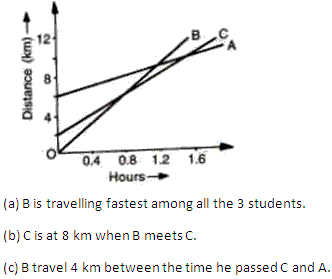
Solution 45
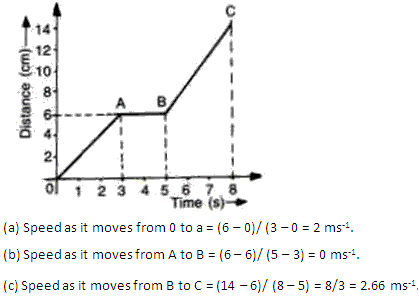
Solution 46
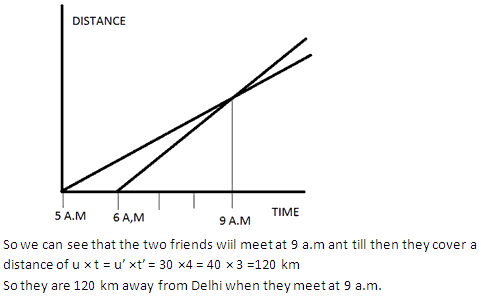
Solution 47
Initial velocity of car u = 18 km/hr.
Final velocity of car v= 36 km/hr.
Time taken by body = 15 min. = 1/4 hr
Acceleration of car a = ( v- u )/t = (36 - 18 ) X 4 = 72 kmh-2.
Final velocity of car v= 36 km/hr.
Time taken by body = 15 min. = 1/4 hr
Acceleration of car a = ( v- u )/t = (36 - 18 ) X 4 = 72 kmh-2.
Solution 48
Initial speed of car u = 50 km/h.
Final speed of car v = 55 km/h.
Time taken by car to attain this speed is = 1 sec. = 1/3600 hr.
Acceleration of the car is = (55 - 50 )X 3600 = 18000 kmh-2.
Final speed of car v = 55 km/h.
Time taken by car to attain this speed is = 1 sec. = 1/3600 hr.
Acceleration of the car is = (55 - 50 )X 3600 = 18000 kmh-2.
Solution 49
(a) 7200 km/h2 = ( 7200 X 1000)/(3600 X 3600) = 5/9 ms-2.
(b) 1/36 m/s2 = (1 X3600 X 3600)/(36 X1000) = 3600 kmh-2.
(b) 1/36 m/s2 = (1 X3600 X 3600)/(36 X1000) = 3600 kmh-2.
Solution 50
initial velocity u = 20 m/s.
Acceleration = 5 m/s2.
T = 2 s.
We know v= u + at.
v= 20 + 5X2= 30 m/s.
Acceleration = 5 m/s2.
T = 2 s.
We know v= u + at.
v= 20 + 5X2= 30 m/s.
Solution 51
acceleration of the car = 10 ms-2.
Initial velocity u = 10 m/s.
Final velocity v = 30 m/s.
We v = u + at.
T = (v- u)/a
T = (30 - 10 )/10 = 2 sec.
Time taken by car is 2 sec.
Initial velocity u = 10 m/s.
Final velocity v = 30 m/s.
We v = u + at.
T = (v- u)/a
T = (30 - 10 )/10 = 2 sec.
Time taken by car is 2 sec.
Motion in One Dimension Exercise 86
Solution 52
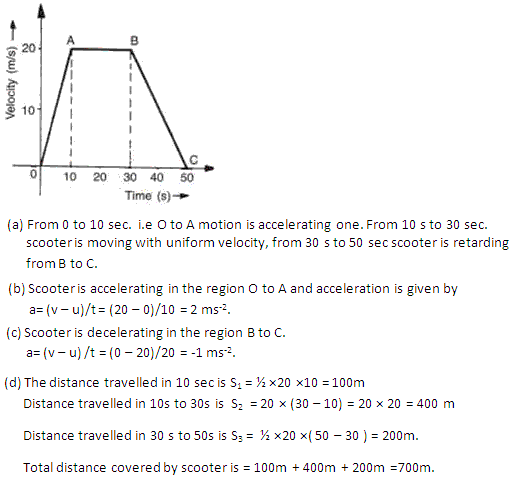
Solution 53
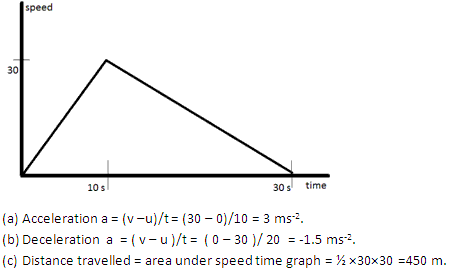
Solution 54
Let total distance be S.
Body covers distance S/2 with speed 40 ms-1 then time taken by him to cover this distance would be T1 =S/2 X 40.
Again body covers rest of the distance S/2 with speed 60 ms-1 then time taken by him to cover this distance would be T2 =S/2 X 60.
So total time taken by body to cover the distance S is T = T1 + T2.
Total time T= S/2 (1/40 +1/60) = s(40+60)/2 X 40 X 60 = s/48.
And average speed = S/T = 48 ms-1.
So average speed is 48 ms-1.
Body covers distance S/2 with speed 40 ms-1 then time taken by him to cover this distance would be T1 =S/2 X 40.
Again body covers rest of the distance S/2 with speed 60 ms-1 then time taken by him to cover this distance would be T2 =S/2 X 60.
So total time taken by body to cover the distance S is T = T1 + T2.
Total time T= S/2 (1/40 +1/60) = s(40+60)/2 X 40 X 60 = s/48.
And average speed = S/T = 48 ms-1.
So average speed is 48 ms-1.
Solution 55
As displacement for the motion from A to B and B to A is zero so the average velocity of the body would be zero.
Solution 56
Initial velocity of body u = 0.5 ms-1.
Final velocity of the body v = 0 ms-1 as body comes to rest finally.
Retardation of body = 0.05 ms-2.
We know that v = u + at.
0 = 0.5 - 0.05t
T = 0.5/0.05 = 10 sec.
Final velocity of the body v = 0 ms-1 as body comes to rest finally.
Retardation of body = 0.05 ms-2.
We know that v = u + at.
0 = 0.5 - 0.05t
T = 0.5/0.05 = 10 sec.
Solution 57
Initial speed of train = 90 km/hr
Speed of train imn m/s = ( 90 X 1000 )/3600 = 25 m/s.
Retardation of the train = 2.5 ms-2.
Final speed of train at platform = 0 m/s.
We know that v2 - u2 = 2as.
0 - 25 X25 = 2 X (-2.5) X s
S = 625/5 = 125 m.
So driver should apply the brakes 125 m before the platform.
Speed of train imn m/s = ( 90 X 1000 )/3600 = 25 m/s.
Retardation of the train = 2.5 ms-2.
Final speed of train at platform = 0 m/s.
We know that v2 - u2 = 2as.
0 - 25 X25 = 2 X (-2.5) X s
S = 625/5 = 125 m.
So driver should apply the brakes 125 m before the platform.
Solution 59
speed of train = 30 km/hr.
Speed in m/s = ( 30 X1000 )/3600 = 50/6 m/s.
Lenth of train = 50 m.
Let lenth of bridge be s metre.
Train has to cover total distance of 50 +s to cross that bridge.
Time taken by train to cover this distance = 36 sec.
So as time taken = total distance /total time taken.
36 = ( 50 +s ) X 6/ 50.
1800 = 300 + 6s
6s = 1500.
S = 1500/6 = 250m
Length of bridge is 250 m.
Speed in m/s = ( 30 X1000 )/3600 = 50/6 m/s.
Lenth of train = 50 m.
Let lenth of bridge be s metre.
Train has to cover total distance of 50 +s to cross that bridge.
Time taken by train to cover this distance = 36 sec.
So as time taken = total distance /total time taken.
36 = ( 50 +s ) X 6/ 50.
1800 = 300 + 6s
6s = 1500.
S = 1500/6 = 250m
Length of bridge is 250 m.
Solution 60
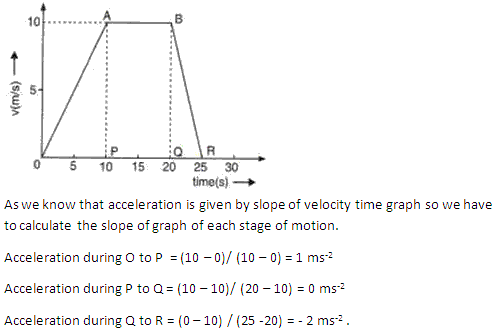
Solution 61
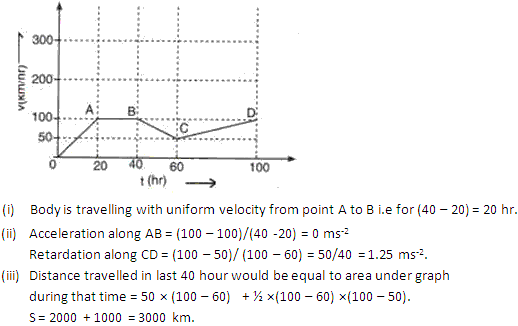
Exercise
Solution
Motion in One Dimension Exercise 87
Solution 62
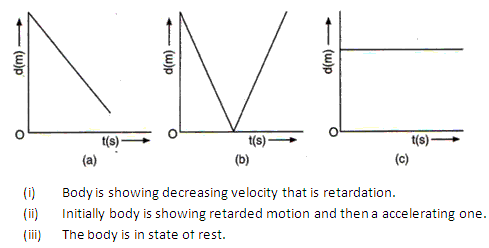
Solution 63
(i) No vehicle is moving with uniform velocity.
(ii) Vehicle B is moving with constant acceleration.
(iii) At 6 seconds both vehicles would meet.
(iv) Velocity of both the vehicles is 60 m/s when they meet.
(v) Vehicle B is ahead at the end of 7th sec and by 70 m.
(ii) Vehicle B is moving with constant acceleration.
(iii) At 6 seconds both vehicles would meet.
(iv) Velocity of both the vehicles is 60 m/s when they meet.
(v) Vehicle B is ahead at the end of 7th sec and by 70 m.
Solution 64
The given question is wrong as distance can never DECREASE with progress of time.

